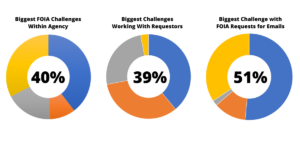
Today’s eDiscovery Blues cartoon gives a nod to our colleagues working in government agencies processing FOIA requests. By law, all federal agencies are required to respond to a FOIA request within 20 business days, unless there are “unusual circumstances.”
The number of requests per year has continued to rise over the past decade, with 858,952 requests in FY 2019 alone, according to the DOJ. Along with this rise in requests, comes an increase in data to search through. So not only are more requests coming in, there is a larger data landscape to sift through in order to find relevant documents.
FOIA Requests Survey
In a recent IPRO webinar series, we discussed various challenges with FOIA officers and analysts in order to take a look at what’s going on currently in the field. In our discussion on 7/29, we surveyed the audience and each question’s leading response points back either to the volume of requests or the need to narrow the scope of the request.

The Biggest FOIA Challenges Within Agency
- Volume of Requests: 40%
- Responsiveness from Other Depts: 33%
- Working Remote: 18%
- Complex Redactions: 10%
The Biggest Challenges Working with Requestors
- Getting Requestor to Reduce Scope: 51%
- Timely Response from IT: 34%
- Clarifying Request from IT: 12%
- We Manage Email Requests Just Fine: 2%
The Biggest Challenges with FOIA Requests for Emails
- Getting Requestors to Narrow Score: 39%
- Expert vs. Novice: 33%
- Requests for Expedited Treatment 25%
- Requestor Appeals: 3%
Leveraging Technology for FOIA / PRR
Many agencies are still trying to meet these challenges with manual processes and off-the-shelf software combinations (such as Outlook, Excel, and Adobe). As data volumes and request volumes continue to grow, this becomes a daunting task at best, even if there were an increase in personnel.
This is where technology specifically designed to manage large datasets and quickly find responsive documents can make life much easier for FOIA officers. Below are a few tools to consider.
De-Dupe / Near-Dupe
These are exactly what they sound like.
De-Duplication (or De-Dupe) identifies and removes duplicate documents on ingestion, greatly cutting down on the document count which must be searched.
A tool which finds Near-Duplicates (or Near-Dupe) uses analytics to find nearly identical documents. This tool can even identify the percentage of duplicate content and conduct side-by-side comparisons of documents, highlighting differences.
Email Threading
This is a tool that identifies email relationships (threads, people involved in a conversation, attachments, and duplicate emails) and groups them together as one coherent conversation. It also gives you the ability to locate the terminal email in a thread, which contains all previous emails leading to it. By looking at the terminal thread, it cuts down searching through multiple emails containing the same content.
Concept Clustering
Concept Clustering is true to its name. It visually groups documents into keyword groups or clusters, allowing you to quickly get an understanding of the data landscape, with the ability to make connections nearly impossible with linear review.
Connecting Directly to Data Sources
By connecting directly to data sources (such as an organization’s email servers, sharepoints, and messaging apps) it allows the FOIA officer direct access to data, rather than having to contact those departments or their IT and request data.
Redaction Tools
Rather than use off-the-shelf tools like Adobe to manually create redactions, the same tools used to search and cull documents, can also create redactions that remove the text under the redaction, run validations to make sure the redactions are burned in and the text is correct, and create layered redactions, so multiple production sets can be sent to multiple parties. They can even identify documents which may need another layer of review before they’re produced, similar to an email platform asking if you want to send without a subject line or if you’ve forgotten an attachment.
Conclusion
Even with the growing number of FOIA requests and the challenges highlighted in this survey, Government Agencies can easily meet the 20-day deadline by leveraging technology and taking advantage of some of the tools listed above, giving officers an edge when it comes to working through those towering stacks (whether they are paper or digital) coming into their inboxes.

